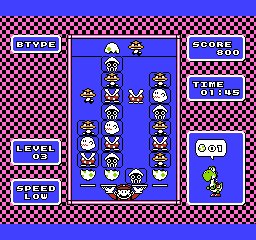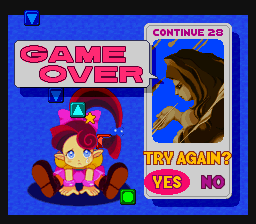This time, Intelligent Systems gets to shine with the brutally competitive but sugary-sweet Panel de Pon.




















| How to Earn | Method | Effect | |||||||||||||||||||||||||
|---|---|---|---|---|---|---|---|---|---|---|---|---|---|---|---|---|---|---|---|---|---|---|---|---|---|---|---|
| Finish a game in Endless with between 50000 and 99999 points | When the Nintendo logo appears on boot-up, press B, A, L then L, a chime will confirm code entry. | The game will now keep speeding up after reaching Level 50 rather than reaching one final speed. | |||||||||||||||||||||||||
| Beat Stage Clear | On the Character Select screen, press L and R on both Controller 1 and Controller 2 at the exact same time. | You can now select Sanatos and Corderia. | |||||||||||||||||||||||||
for Vs. COM |
Beat Vs. COM on Hard difficulty | On the Set Level screen for Vs. COM, highlight Hard then hold Up and L then press A. | You will now start Vs. COM on Super Hard, the highest difficulty. | ||||||||||||||||||||||||
in Vs. COM |
Beat Vs. COM on Super Hard while using at least one continue. | Between stages in Vs. COM mode, hold X and Y until the screen fades out. | You can select which of the currently-freed friends will represent you in the next stage. | ||||||||||||||||||||||||
| Beat the Normal Puzzle stages. | Enter the password NYD29JI. | You can move on to another set of harder puzzles. | |||||||||||||||||||||||||
| Beat the Extra Puzzle stages (only shown in Tetris Attack). | Press A, B, Start and Select all at once. | You will reset the game. Works in both versions. |













































































| JP Title | EN Title | Platform | Year | Vs. COM | Endless | Score Attack | Puzzle | Puzzle Hints | Stage Clear | 1P Garbage | 3D Mode | 2-Player Vs. | 4-Player Vs. | Online |
|---|---|---|---|---|---|---|---|---|---|---|---|---|---|---|
| Panel de Pon | Tetris Attack | SNES | 1995 |  y y |
 y y |
 y y |
 y y |
 n n |
 y y |
 n n |
 n n |
 y y |
 n n |
 n n |
| Yoshi no Panepon | Tetris Attack | Game Boy | 1996 |  y y |
 y y |
 y y |
 y y |
 n n |
 y y |
 n n |
 n n |
 y y |
 n n |
 n n |
| N/A | Pokémon Puzzle League | N64 | 2000 |  y y |
 y y |
 y y |
 y y |
 n n |
 y y |
 n n |
 y y |
 y y |
 n n |
 n n |
| Pokémon no Paepon | Pokémon Puzzle Challenge | Game Boy Color |
2000 |  y y |
 y y |
 y y |
 y y |
 y y |
 y y |
 y y |
 n n |
 y y |
 n n |
 n n |
| Nintendo Puzzle Collection Panel de Pon |
N/A | Gamecube | 2003 |  y y |
 y y |
 y y |
 y y |
 y y |
 n n |
 n n |
 y y |
 y y |
 y y |
 n n |
| Nintendo Puzzle Collection Panel de Pon |
N/A | Game Boy Advance |
2003 |  n n |
 y y |
 n n |
 n n |
 n n |
 n n |
 y y |
 n n |
 n n |
 n n |
 n n |
| Dr. Mario + Panel de Pon |
Dr. Mario + Puzzle League |
Game Boy Advance |
2005 |  y y |
 y y |
 y y |
 y y |
 y y |
 y y |
 y y |
 n n |
 y y |
 n n |
 n n |
| Panel de Pon DS | Planet Puzzle League Puzzle League DS |
DS | 2009 |  y y |
 y y |
 y y |
 y y |
 y y |
 y y |
 y y |
 n n |
 y y |
 n n |
 y y |
| Chotto Panel de Pon | Puzzle League Express A Little Bit Of... Puzzle League |
DS | 2010 |  y y |
 y y |
 y y |
 n n |
 n n |
 y y |
 n n |
 n n |
 n n |
 n n |
 n n |
| Tobidase Dōbutsu no Mori Amiibo Purasu |
Animal Crossing: New Leaf Welcome amiibo |
3DS | 2010 |  n n |
 y y |
 y y |
 n n |
 n n |
 y y |
 y y |
 n n |
 n n |
 n n |
 n n |
| Panel de Pon | Panel de Pon | Switch (SNES Online) |
2020 |  y y |
 y y |
 y y |
 y y |
 n n |
 y y |
 n n |
 n n |
 y y |
 n n |
 y y |
| N/A | Pokémon Puzzle League | Switch (Nintendo 64 Online) |
2022 |  y y |
 y y |
 y y |
 y y |
 n n |
 y y |
 n n |
 y y |
 y y |
 n n |
 y y |










